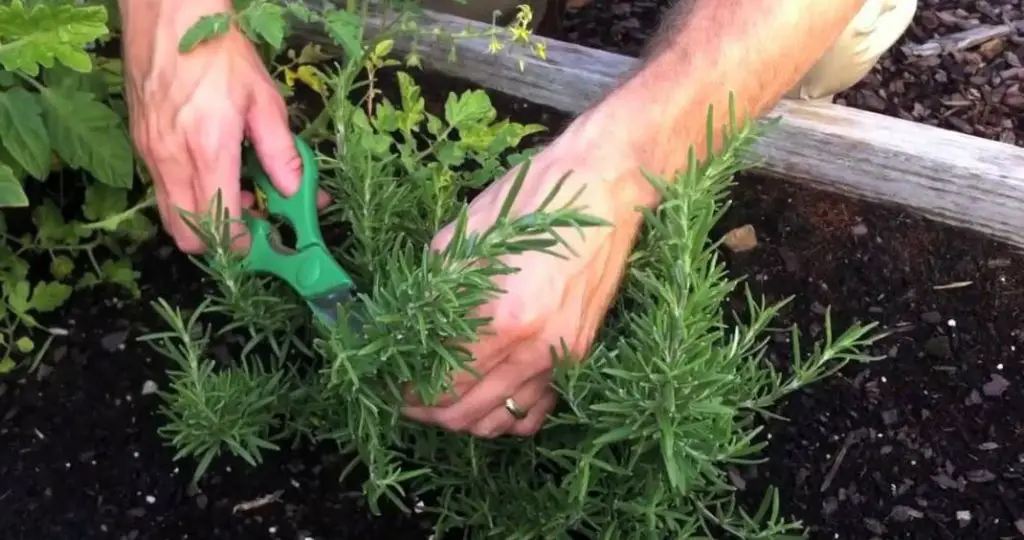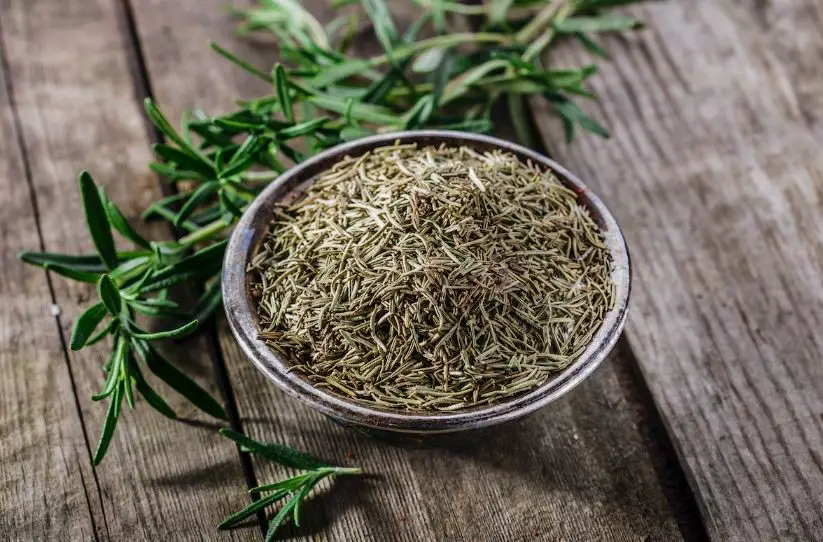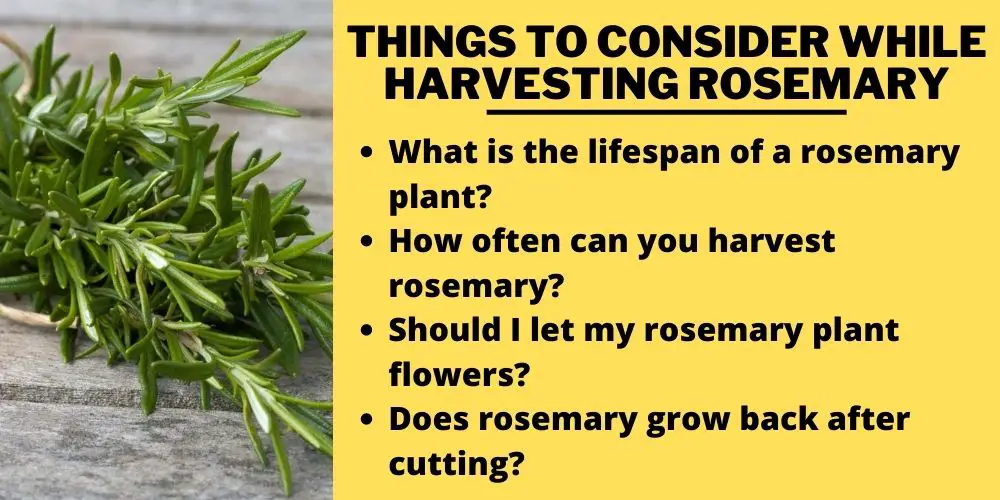Harvesting rosemary seems simple. But do it wrong, and the plant may suffer. Our goal is different. We want to pick tasty sprigs and see our plant thrive.
In this article, we teach that art. Learn which tools to use. Know how to harvest rosemary without killing the Plant.
Understand where to make cuts. We guide you to do it right. Let’s enjoy fresh rosemary from our gardens, without causing harm. Let’s start this rewarding journey of sustainable harvesting today.

Table of Contents
How to Harvest Rosemary Without Killing the Plant?
Here’s a concise guide on how to harvest rosemary without killing the plant:
- Selection: Choose the right time to harvest, typically in the morning after the dew has dried but before the sun gets too hot. The plant should be at least 6 inches tall and in good health.
- Tools: Use a sharp, clean pruning shear or scissors. Clean tools prevent disease transmission.
- Method: Identify the branch you want to cut. Ensure it has plenty of leaves but is not the main stem. Make your cut about 2-3 inches from the plant’s base, just above a leaf joint. Do not remove more than 1/3 of the plant at once to avoid shocking the plant.
- Frequency: Harvest regularly, but sensibly. Over-harvesting can weaken the plant. Allow it to recover before harvesting again.
- Post-harvest Care: After harvesting, maintain proper watering and fertilizing practices. Healthy plants recover faster.
Take extra care during late fall and winter, as these are the plant’s resting periods. Hopefully, following these steps will ensure a never-ending supply of fresh rosemary sprigs from your garden.
The Best Time to Harvest Rosemary
Timing is critical when harvesting rosemary. The ideal period is mid-spring to early summer when the plant is in active growth and filled with essential oils. This ensures not only a bountiful harvest but also the most aromatic and flavorful yield.
The best time of day is in the morning, right after the dew has dried off but before the sun gets too hot. This is when the essential oils in the plant are most potent, delivering the best aroma and flavor from your harvested sprigs.
Pro Tips for Sustainable Harvesting
Remember not to harvest more than 1/3 of the plant at a time. Frequent, moderate harvesting promotes bushy growth. Prune your rosemary at least once a year (early spring is a good time) to keep it in good condition and prevent it from becoming too woody.
With patience, attention, and these tips in hand, you’ll be able to enjoy a bountiful rosemary harvest without compromising the health or longevity of your favorite herb plant.
Post-Harvest Care: The care doesn’t stop once you’ve snipped your sprigs. Helping your plant recover and continue to thrive post-harvest is crucial. After harvesting, water the plant thoroughly. Regular watering (but not overly soggy conditions) paired with full sun will strengthen your plant for future harvests.
How do you prune rosemary in pots?
Regardless of where the plant is growing, the pruning method is similar. The only difference with a pot is ensuring that the plant is pruned so that it continues to be maneuverable.
Garden-grown rosemary can go wild and crazy, but you want to keep potted plants more shaped and clean. There’s nothing worse than trying to move a pot around and getting stabbed by wayward branches.
How do you dry, store and use rosemary?
Drying
There are a couple of ways to dry rosemary, but the best is by hanging it up. All you need to do is grab a bunch of sprigs (6-7) and tie them at the base using some string/twine or a rubber band. Hang them upside down in a dry, well-ventilated area where it doesn’t receive direct sunlight.
They should be crushable by 14-21 days. At this point, you can add them to a shaker for later use or use them in your favorite recipes. Dried rosemary will generally last around a year. Of course, their potency will minimize over time.

Storing
Storing rosemary fresh is as easy as wrapping some sprigs in a damp paper towel and placing them in an airtight storage container or Ziploc bag. It should last for 10-14 days using this method.
Usage
Using rosemary is based on personal preference. It’s generally best with mats such as chicken, beef and lamb, fresh or dry as a rub. One of my favorite uses is on baked vegetables, especially potatoes! Soups, casseroles, salads and stews are also great uses for this fragrant herb.
Can you freeze fresh rosemary?
Rosemary will keep exceptionally well in your freezer. Simply place your desired amount of sprigs in either an airtight container or freezer bag. Make sure you remove any excess air from the bags before freezing.
Another option is to trim the springs into smaller segments and add them to ice cube trays with water or olive oil. The latter is a great hack for quick weekday meals.
Things To Consider While Harvesting rosemary
There are a couple of “minor issues” to consider when harvesting your rosemary. The plant itself is pretty simple to harvest, but these points are worth taking note of regardless:

What is the lifespan of a rosemary plant?
A rosemary plant generally takes around a year to establish itself. You can reduce the time in half by using cuttings instead of growing from seeds. The overall lifespan of this wonderful herb can span out to as long as 10+ years if maintained correctly.
How often can you harvest rosemary?
Like any herb, you want to encourage continual growth as often as possible. A simple weekly trim routine is advisable to promote regeneration and shape your plant the way you want.
When doing so, never prune more than ⅓ of the plant at a time. Removing too much foliage will send your rosemary into shock, and you will need to carefully balance its conditions to get it up and going again.
Should I let my rosemary plant flowers?
The best way to keep some kind of control over your rosemary is to prune it in a maintainable, compact manner. You can achieve this by cutting the plant’s stems back after the blooms begin to fade away. If you let them continue to grow, they will become leggy.
As a result, you’ll have to wait until the stems grow out a fair bit, then trim them back without letting them flower again. This process is required to produce strong stems again.
Does rosemary grow back after cutting?
Rosemary grows back after cutting. It generally takes 6-8 weeks to completely grow its stems back after being trimmed. A word of warning when it comes to pruning, though, never cut the brown, woody parts at the lower section of the plant. They will stop growing from that point.
A hot tip to try is to hard prune the plant over winter. It won’t grow in this period, but when spring comes around, it will go bananas!
You may also find useful: Rosemary Turning Black Reasons & Easy Solutions
Frequently Asked Questions (fAQs)
When to harvest rosemary for drying?
The fragrant oils of rosemary are at their peak potency just before they flower. This is the best time to pick them for drying as the drying process can sometimes air out some of the oils. The more that you have in the beginning, the better. Try to pick them up in the mornings after all the previous dew has evaporated.
How do you pick rosemary, so it keeps growing?
If you only require small amounts, pick the upper 1-2 inches at will. If you want greater amounts, take longer lengths of the stems but aim to prune no more than ⅓ of the plant at the time and allow it to regenerate fully before picking again.
This should take 6-8 weeks for them to grow back to the length they were before. Removing your desired amount just above a growth node promotes continual growth.
Does rosemary come back every year?
Rosemary is a perennial plant. This means that it will continue to produce its leaves year after year. It can grow up to around 10+ years if grown in optimal conditions.
How do you keep rosemary from going woody?
Rosemary plants will go woody if they have been pruned too low. When you trim a rosemary plant down as low as the brown, woody stems, they will continue to grow hard wooden stems instead of green, leafy stems. Always trim the stems 1-2 inches above the greener midsection to avoid this issue.
Conclusion:
Rosemary is a joy to use because of its wonderful fragrant smell and woody characteristics. It can be used in various culinary delights and healing oils; its byproduct can produce some handy health benefits.
Learning how to harvest rosemary without killing the plant isn’t a tough task as long as you know what you’re doing.
We hope that we have helped to walk you through the process, and we look forward to producing more content like this in the future. Happy growing!


